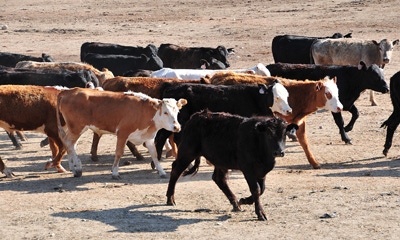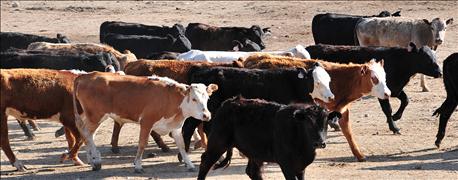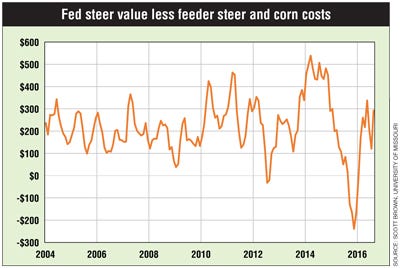November 3, 2016

The weight at which animals enter feedlots has risen for much of the past five years.
Though the trend was already in place in the heavier category, the growth has accelerated since 2011. The price that feedlots will pay for animals depends upon many factors, but two of the most important are the expected cost to add weight to those animals and the price at which they will be sold after feeding.
 HEAVIER CALF TREND: The price that feedlots will pay for animals depends on many factors, including the expected cost to add weight to the animals and the price at which they will be sold after feeding.
HEAVIER CALF TREND: The price that feedlots will pay for animals depends on many factors, including the expected cost to add weight to the animals and the price at which they will be sold after feeding.
It was not surprising that feedlots were less interested in purchasing lighter-weight animals with corn prices above $5 per bushel, which was the case from February 2011 through September 2013. But now that corn has been below $4 per bushel for the last two years, why are feedlots continuing to place heavier animals? And what might that mean for your operation?
The move to heavy calves
The answer to the first question includes many different factors, including the number and age of animals available to be placed into feedlots in not only the U.S., but also Canada and Mexico. Also at play are winter wheat and pasture conditions, which can make it wise economically to add more weight to animals from grazing; or, at times, force animals into the feedlot quicker due to lack of available forage.
Price volatility has also been an issue. Even as feed prices have stabilized in recent months, fed and feeder cattle prices have moved in large increments recently, greatly increasing risk. The table shows the cash fed steer price for a given month less the cash cost of a feeder steer five months earlier, and the average cash cost of feeding 50 bushels of corn between purchase and sale date.

Though price risk management is often able to reduce the volatility shown in the table, there is a cost to managing that risk, and feedlots have had few chances to lock in profitable margins lately. Owning animals for a shorter period of time has been one way to moderate that uncertainty — thus, a demand for heavier-weight cattle entering the lot.
Best way to market calves
How might this information impact decisions made on your operation? First, realize that things have changed in the last few years. You may now have a better financial option for marketing your calves than what was the optimal outcome five years ago.
Here are a few questions to consider moving forward:
• Can you add weight more cheaply to your animals than what the market will pay for that additional weight?
• Is a backgrounding operation now willing to pay more for your calves than a feedlot?
• Are you confident in your ability to manage the risk involved in owning your calves for longer than before?
Perhaps the best strategy for you is already the one you have in place. But realizing when changes in the market have occurred and analyzing what leads to your best financial outcome is never a mistake, and can lead to greater profitability on the farm.
Brown is a livestock economist with the University of Missouri. He grew up on a diversified farm in northwest Missouri.
You May Also Like




